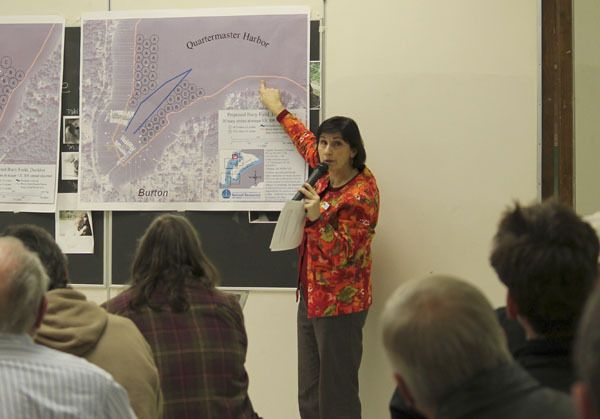The state’s plan to more closely manage boat moorage in Quartermaster Harbor received a mixed reception from Vashon’s boating community last week.
At a public meeting on Thursday, Islanders expressed concerns and frustration over the number of spaces the state has proposed for boats in the harbor as well as the costs boaters will face to comply with the new regulations.
“We’d probably have to sell our boat because of this plan,” said Theron Shaw.
The state Department of Natural Resources (DNR) has been working for about 18 months on a proposal to reduce congestion in the harbor and minimize the impact of boating activities on the environment.
At its latest meeting on Vashon, Lisa Randlette, a planner with DNR’s Aquatic Resources Division, spent nearly two hours answering questions about the state’s draft plan, which was just completed. The public can comment on the plan through Jan. 7.
One of the chief concerns at the meeting was about the size of two buoy fields proposed for Burton and Dockton — the two most congested parts of the harbor.
The state has laid out 73 spaces where buoys can be placed in those areas, though waterfront homeowners can moor on private tideland or apply to place a buoy near their home. Many at the meeting said the plan should allow for more growth in the harbor; based on buoy applications already submitted, only a dozen more boats could join the buoy fields.
“In five or 10 years, sometime down the road, there will need to be more,” said one woman. “The whole plan needs to be revised for more people.”
Don Wolczko, a longtime boater on Vashon, agreed.
“Most projects don’t just work with the current set of parameters, they look into the future,” he said.
Randlette said the buoy fields were determined by questioning Islanders on how far from shore one would reasonably moor a boat and then placing buoy spots within those areas with a wide berth for safety. However, she added, the state could consider adding more spaces farther from shore.
“We think it’s a reasonable amount, but we’re not saying that’s an absolute,” she said.
Another significant concern was the plan’s stipulation that all boats be attached to the type of anchor system currently required by the state, which is more secure and environmentally friendlier than most in the harbor. Installation of the anchors, however, can run between $2,000 and $5,000, depending on the size of the boat.
In addition, boaters will have to begin paying for moorage in the harbor, an annual cost of $175 to $562, depending on boat size.
“You are in essence saying boating is only for rich people,” said Lori Gustavson, a longtime boater who said she moors her boat with the “bums.”
“Please consider there are people who enjoy boating (and) who have the right to be on a buoy but can’t pony up the bucks,” she said.
Some questioned whether the state could purchase and lease out buoys, while others suggested that perhaps boaters could make some minor modifications to their existing buoys instead of installing entirely new ones.
“Would it really make a difference, if you make it so (the line) doesn’t drag the bottom?” asked Bruce Morser.
Randlette said her department was sympathetic to those who would have to install new systems, but the anchor requirement has already been set by other agencies.
“We’re not in this alone,” she said. “It’s my understanding that the regulatory agencies prefer the embedded anchor system.”
She also noted that by creating one permit for buoy owners and ending the requirement to apply with multiple agencies, DNR would save boaters hundreds of dollars in application fees.
Once the state has reviewed both verbal and written comments from Islanders, it will take its finalized plan to King County, the state Department of Fish & Wildlife and the Army Corps of Engineers to obtain the permits required to enforce the regulations. As soon as this August, it could begin asking boaters to install new buoy systems and removing buoys it has determined are abandoned.
Randlette emphasized that there is still time for the plan to be tweaked.
“That’s why we have this as a draft and we’ve ask you … to give us feedback on it,” she said. “We’re really trying to work with the community and accommodate as much as we can.”
To view the plan, see www.dnr.wa.gov/ResearchScience/Topics/SEPANonProject/Pages/amp_sepa_nonpro_quartermaster_mar.aspx. Comments can be emailed to sepacenter@dnr.wa.gov or mailed to Washington State Department of Natural Resources, SEPA Center, P.O. Box 47105, Olympia, WA 98504.



